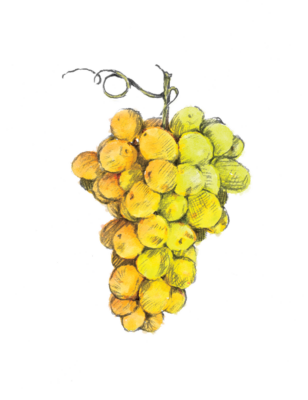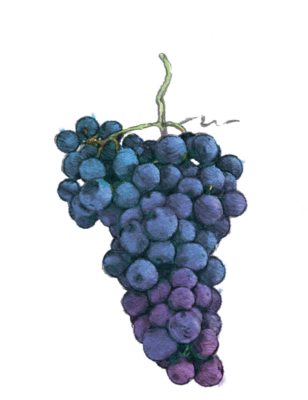Many of the world’s great wine regions are intrinsically linked to specific grape varieties. Where is New Zealand’s reputation without Sauvignon Blanc? Piemonte without Nebbiolo? It goes far beyond reputation with some regions, so much that some governing bodies have imposed restrictions as to what grapes can be planted, and where. Much of this is determined by tradition, with European regions working off of hundreds of years of empirical data and research. Commerce and marketing play large roles too, as they often do in the world of wine.
For example…
Chianti Classico DOCG
- Sangiovese must comprise a minimum 80% of the Chianti Classico blend, but may be up to 100%.
- From the 2006 vintage, white grapes are no longer permitted in the wine.
The restrictions only continue from there, with both aging time and alcohol content regulated.
In Burgundy, monks chronicled viticulture since the 5th century and their influence has led to the grape Gamay being banned (or rather banished further south to Beaujolais) – it was feared that Gamay “compromised the quality image of Bourgogne wines they were trying to promote” and Pinot Noir, despite its intrinsic difficulties in the vineyard by comparison, became highly favoured in Burgundy.
With the introduction of the Appellations d’Origine Contrôlée (AOC) system in 1935 – “…the reorganization of the Bourgogne winegrowing region favored the Chardonnay and Pinot Noir grapes, which now represent over 80% of all vines planted in the region.” (Vins de Bourgogne)
This is all to say, that by comparison – things are pretty chill in the United States! Generally speaking, vignerons can plant what they want, vinify it and bottle it to their heart’s content! And with the post-prohibition-era of New York State wines only sporting a century or so of history, we’re in the midst of an early renaissance! It’s fueled by curiosity, by a sense of adventure and experimentation and exploration – the skies the limit! At the end of the day, a set of laws can’t create quality.
Now, even in its youth, New York State, has developed a reputation for specific things – both locally and abroad. I asked around my wine communities in both New York City and in London, simply “What is New York State Wine known for?”
Their answers were not surprising! The Finger Lakes has built a solid reputation for Riesling, with Cabernet Franc getting a well deserved honorable mention. Long Island is boasting excellent expressions of Chardonnay and Merlot. Pinot Grigio, sparkling wines and native varieties also received mention.
I submit that these assumptions are premature! Should we rally all our marketing strength behind a single variety? Should American governing bodies step in and declare that the Finger Lakes can produce nothing but Riesling? Should Napa rip up anything that’s not Cabernet Sauvignon and Chardonnay? OF COURSE NOT. There’s still so much to learn!
Let’s explore the vineyards together through the lens of six “Unsung Grapes” of New York State! You may discover a new favourite! In my chats with the producers of each wine we’ll look at the factors that go into choosing what varieties to plant; a grape’s suitability for New York terroir; their viticultural pros and cons; and – if these varieties have a future in New York State? Away we go!

ALBARIÑO
Palmer Vineyards, 2020 – North Fork of Long Island
Albariño (al-bar-EEN-yo) is a white skinned grape variety with its origins in Portugal, and it’s notoriety from its success in Spain’s Rías Baixas region, both coastal areas. Some believe it has surpassed even white Rioja (made with Viura) for Spain’s most popular dry white wine. The wines, often produced fresh and unoaked, are floral, and citrusy with stone fruits on the palate – however they tend to be less aromatic than other varieties, such as Riesling. The wines boast high acidity and are considered excellent with seafood.
The 2020 Albariño from Palmer Vineyards does not disappoint. It is a testament to the grape’s success in maritime climates. The finish is distinctly saline, like an ocean breeze, with high-toned acid and a long finish. I could not imagine a better wine for al fresco dining – I want fresh oysters and shrimp cocktail – and sea views of course!

CHENIN BLANC
Paumanok Vineyards, 2020 – North Fork of Long Island
Chenin Blanc’s (SHEN-in BLAHNK) ancestral home is, and its most famous wines come from, the Loire Valley in France. The grape is a natural cross of Savagnin and an unknown parent. The wines are made with varying levels of sweetness and can produce both stunning dry and sweet styles. The best examples are complex tapestries of apples and honey, minerality, acidity,
and are long-lived wines. Excellent for matching with a wide range of foods. Seafood, cream sauces, pork chops and applesauce are just a few that come to mind. The grape also thrives in South Africa, where it’s sometimes called Steen.
The 2020 Chenin Blanc from Paumanok Vineyards is complex and textured, a dinner table all-star! This is an unoaked wine produced in stainless steel, but it’s not unheard of to utilise other vessels in its production. Sharp acidity for cutting through rich dishes, minerality that begs for shellfish. Tart apple on the nose and rounder baked apple and tropical fruits on the palate, with a long finish – stony, zesty lime. Mouth watering!
I caught up with Palmer & Paumanok winemaker, Kareem Massoud to chat all things Albariño & Chenin Blanc on Long Island!
What factors do you consider when planting a grape variety that doesn’t have proven success in your region?
We go back far enough that anything planted in our region was new! And some new varieties — such as our Chenin Blanc — were more attributable to serendipity than anything else. My father decided to keep the Chenin vines he had begun ripping out after a German vineyard manager we had at the time pointed out how well the vines were growing, and long story short, we
decided to keep them. The Chenin has turned out to be one of our most successful wines.
That said, we have recently planted Melon de Bourgogne at Paumanok. Factors considered in this decision included the success we have had with other Loire varieties including Chenin, Sauvignon Blanc and Cabernet Franc. And the analogous terroir of Muscadet relative to Long Island. Both are maritime districts near the Atlantic with similar annual heat and rainfall
accumulations.
Are the grapes well suited to NY terroir? Viticultural Pros v Cons?
With regard to Chenin Blanc and Albariño, the short answer is yes. As far as viticulture, Chenin is very rot susceptible and that makes it very problematic in warm, wet vintages. The Albariño is thick-skinned and can withstand such conditions better, but takes longer to ripen. Both are worth
the aggravation in relation to the reward.
Do you think there’s a future for the grapes in New York State? Should more growers plant it?
Absolutely. Over the decades (yes, it has been decades, our first Chenin was produced in 1992), we have often been asked how come no one else grows it. A question to which we do not have a good answer other than possibly brand recognition. The public is not familiar with the name Chenin as they are with Chardonnay or Sauvignon Blanc. It is more difficult to grow than
Sauvignon as it ripens later, and both are similarly rot susceptible, that being the case it is not surprising that a grower would favor Sauvignon over Chenin. Like We believe Chenin is worth the extra trouble and tender loving care.
As for Albariño, yes, absolutely. As a thick-skinned, high acid white variety it makes a lot of sense on Long Island, I’m not sure about the rest of New York though. There is so much bounty from the seas that surround us that will pair beautifully with either the Chenin or the Albariño.



GRÜNER VELTLINER
Hosmer Winery, 2019 – Finger Lakes, Cayuga Lake
Grüner Veltliner (GREW-ner VELT-leaner) is the leading white grape of Austria. It can be made in a range of styles from easy drinkers to serious, complex, long lived wines. The latter is often aged in large format old oak, the former in neutral vessels. The wine’s signature is the white pepper note – found in the bouquet and on the finish. This is due to the presence of the compound rotundone found in the grape skins. It is rarely blended, and often approached with purity in mind. It boasts high acidity, with flecks of green legumes and pairs well with food. Outside of Austria, it is grown very little, and even less outside of eastern Europe.
The Hosmer Winery 2019 Grüner Veltliner is a joy to drink. The signature white pepper aromas are unlocked with a short swirl in the glass, and dances with zesty grapefruit. On the palate, just a touch of residual sugar unlocks riper fruit character, young peaches, and finishes with a lingering lemon basil spice. This is a well structured wine that is sure to please all palates!
I had the pleasure of chatting with Hosmer winemaker, Julia Hoyle about the unique factors that determine a grape’s viability in the Finger Lakes, and why Gruner is a winner!
When choosing an untested grape variety, what factors to consider are specific to the Finger Lakes?
The Finger Lakes region has two major factors to consider when planting a grape variety with little track record in the region – Will it get ripe enough? Will it survive our winters? Both of the answers need to be yes to grow quality grapes. It would be a very expensive project to pour time and money into establishing a vineyard that ripens fully only one out of every ten years, similarly why establish a vineyard that may have substantial vine death come a cold winter. The extreme temperature swings of winter do not seem to be going away with climate change, in fact, it seems that they will become more frequent. Establishing a vineyard that can withstand extreme temperatures during the winter is essential. There is research to consult which grapes may do well in our region, but if you have a passion for a particular grape, you may need to trial it yourself. Data only exists if someone has plantings to extract data from.
What makes Grüner Veltliner unique in the glass?
I find that our expression of Grüner Veltliner is rich, but still carries a smokiness that I would expect from Grüner Veltliner both in our region and from Austria. It is a bit more lush than tight and acid-driven. Both the fruit coming in, and the yeast strains that I select add to this round character. Looking back on previous vintages of our Grüner Veltliner, I am pleased with how well they are aging. Given that our plantings only date to 2013 and I had never worked with the grape until 2017, it is a fascinating variety for me!
Do you think there’s a future for Grüner Veltliner in New York State?
I absolutely think that there is a future for Grüner Veltliner! On the marketing side, it is a harder sell to the general wine consumer. The grape name looks scary and long, and the general consumer is probably unfamiliar with the variety. This has changed in recent years, and I expect
that it will continue to gain traction. Would I build a Finger Lakes vineyard and brand around Grüner Veltliner? Probably not. Is it a fascinating and fun addition to a vineyard and winery portfolio? Absolutely. As we see more wine savvy people visiting the region, I expect to see an increase in demand for the grape (wineries) and the finished product (consumers).


ZWEIGELT
Weis Vineyards, Dry Rosé 2020 – Finger Lakes
Zweigelt (ZVEYE-GELT) is an Austrian cross of blaufränkisch and St. Laurent made in 1922 by Fritz Zweigelt! With over six thousand hectares planted, it is easily Austria’s most significant red variety. It ripens earlier than blaufränkisch and is not as susceptible to disease, or frost. The grape produces soft wines with red/purple fruit and easy drinkers are most prevalent. It is common in red blends, especially burgenland.
The first thing that strikes you with the 2020 Weis Vineyards Zweigelt Dry Rosé is the colour – no instagram filter needed! It’s electric. (boogie-woogie-woogie.) I coravin’d a sample at home – it was a monday morning. But what an excellent breakfast/brunch wine this is! I could start to pick up the fruity aromatics while the glass was still on the coffee table in front of me. Very attractive stuff. A slight effervescence (it was very recently bottled), with prickly acidity and a way-too-easy texture, bordering on hedonistic.
…the rest of the bottle did not see the sunrise on Tuesday morning.
Always great to link up with winemaker Peter Weis for a chat, getting the 4-1-1 on Zweigelt in the Finger Lakes:
What is the key to success when choosing to work with a new grape?
First, does the varietal fit into our wine profile? Second, since NY is a harsh environment for grapes, is the varietal cold-hardy, and what is its ability to fully ripen?
Is zweigelt well suited to your terroir?
Yes, it grows well here. It is slightly more winter tender so it needs to be grown in our warmest vineyard locations. It is on the early side of ripening so we always get ripe fruit.
Do you think Zweigelt offers something unique compared to other varieties commonly grown in the Finger Lakes?
The vibrant flavor profile with nice bright berry and fresh strawberry aromatics makes a nice contrast from many of the cool climate style reds of our region.
Do you think there’s a future for the grape in New York? Should more growers plant it?
I think there will be a future in the region, but not on a large scale, more of a niche product. Since the variety needs to be grown in a warmer vineyard site the location options are limited.


TEROLDEGO & LAGREIN
Lieb Cellars, Estate 2019 – Long Island
Teroldego (Tare-ol-dih-go) is a leading red grape variety of Trentino-Alto Adige, the northernmost region in eastern Italy. The wines are structured, with black berries, tar and fresh acidity.
Teroldego spontaneously crossed with an unknown variety that produced Lagrein (Lah-Grayne). The grape is primarily grown in the Alto Adige region, producing red-fruit driven, black pepper spiced wines with bitter notes.
Thoughts on the Lieb 2019 Teroldego-Lagrein? I really can’t put it any better than Russell does below! I enjoyed the wine with lamb kebabs and turkish flatbread. It married so well! With enough acidity and freshness to cut through the fats and oils, but medium bodied, and the six months in Hungarian oak was just enough – great balance, really tasty dark fruits.
Great chat as always with winemaker Russel Hearn – talkin’ teroldego!
How does Teroldego stack up in the vineyard? Is it well suited to the Long Island Terroir?
I would say yes due to our cool climate which allows it to ripen during moderate 70-75F temperatures but retain its natural acidity. It has a medium-to-loose cluster structure and minimal berry on berry contact which reduces fungal disease. It’s also fairly early-ripening (beginning of October) so it has plenty of ripening time, even in a cool year for us.
What do you like about this particular variety in the glass that makes it stand out?
It has an impressive dark color which sets up the taster to think ‘this will be good’. There are bright fruit aromatics of cranberry, pomegranate, blackberry and raspberry. Acidity is medium-high which is optimal for food pairing, and this wine bridges the gap between whites and heavier reds. It can pair well with pasta, chicken or duck which a lot of reds do not
complement. It also shows really well in its youth which is often not the case with Merlot or Cab Franc from New York.
Do you think there’s a future for the grape in New York? Should more growers plant it?
Yes, I believe it’s very well suited to New York and that’s been proven by producers in the Finger Lakes before us, including Red Tail Ridge. Cool climate red varieties that can handle humidity are important for our region, and Teroldego is proving to be one of them.


SAPERAVI
Dr. Konstantin Frank, 2018 – Finger Lakes
Saperavi (Sah-Per-Rav-ee) is a very old Georgian variety (Europe, not Atlanta), whose name means “dye”. It is a teinturier grape, meaning a red grape with both dark skins and pigment in its flesh. In contrast, regular red wine grapes have dark skins, but clear flesh. It is the most widely planted grape in Georgia today. It makes deep, dark, bold dry wines. Traditionally the wine is fermented underground in qvevri, vessels made of clay.
The 2018 Saperavi from Dr. Konstantin Frank is fermented in temperature controlled stainless steel, and aged in French oak for 16 Months – 20% New, 80% 2-4 YO. The wine is deep violet, with aromas of vanilla, cedar, smoke, and stewed fruits on the nose. The palate is big and lush and sleekly textured; it finishes fresh and lifted. To be enjoyed with beef stew, a ribeye with steak sauce, or a good cigar.
I spoke with my friend Meaghan Frank of Dr. Konstantin Frank Vinifera Wine Cellars – her family winery made a name for themselves entirely based on unproven varieties:
Konstantin knows all about experimental plantings!
Yes! Many of our esoteric varieties were planted by Konstantin in the 1960s and none of them had proven success prior to planting – but he particularly focused on varieties that thrive in a cool-climate. Since then we have added additional unique varieties like Gruner Veltliner and Blaufränkisch which have done well. My father Fred knew that due to the cooler climates of Austria and Germany in the case of Lemberger that the variety should work in the Finger Lakes too.
Is the grape well suited to Finger Lakes terroir?
Saperavi is really well suited to the Finger Lakes. It is a cold-hardy vinifera variety in which the buds survive even in the coldest of winters. Konstantin used to say that in the winter in Odessa, your spit would freeze before it hit the ground and Saperavi flourished there. Saperavi is a really interesting variety because it seems to do well in both colder and warmer climates. There was a winery that I visited in Australia while I was finishing my graduate degree, Hugh Hamilton in McLaren Vale – and I was shocked and excited to see they had Saperavi planted. I spoke to them about it and they said it does very well and for them, a pro was that it holds its acidity. For us, that is a given in our climate with most of the varieties we work with.
What do you like about this particular variety in the glass that makes it stand out amongst other NYS wines?
Saperavi is a variety to make incredibly deeply hued, bold wines. In our region of the FLX, that is not always easy in the cool climate that we have. Due to the fact that it is a teinturier variety, you can guarantee that you will have a deep dark color every vintage.
Do you think there’s a future for the grape in New York?
Konstantin was certainly on to something when he decided to plant it on Keuka Lake in 1958. It was virtually unknown until 2013 where it finally received TTB approval to call it by the varietal name. Before then, we had to name it a proprietary name. Now that it is a recognized grape in America, we are seeing plantings of this variety explode between growers planting it and other wineries beginning to experiment with it. There is a huge potential for this variety in our region. We just need to educate more consumers about it!
I couldn’t agree more!
A big thank you to all the producers that shared their wines and their stories with me! Now go out there and find a bottle of New York State wine made with one of your newly discovered grapes! There are SO MANY more out there to try. What are you waiting for?! Get your grape on.
Sources:
https://www.bourgogne-wines.com
http://www.courtofmastersommeliers.org
Brook, Stephen “The Wines of Austria” Second Edition, 2020
MacNeil, Karen “The Wine Bible” Second Edition, 2015

